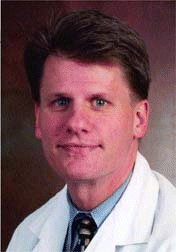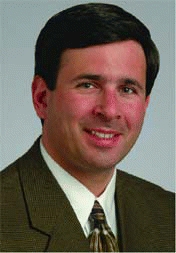Otolaryngologist Martin L. Hopp, MD, PhD, of Cedars-Sinai Hospital in Los Angeles, believes that in-office computed tomography (CT) scanning is the trifecta of care for otolaryngologists and their patients. This technology, he enthused, is a three-pronged positive effort. It’s wonderful for any otolaryngologist who wants to improve patient care, reduce patient cost, and increase office income.
Explore This Issue
January 2008We were able to get adequate biopsy results 93% of the time without the patient having to go to a hospital-based institution, said the study’s lead author, David L. Steward, MD, Director of the Thyroid and Parathyroid Program and Associate Professor in the Department of Otolaryngology/Head and Neck Surgery at the University of Cincinnati.
Newer, compact CT scanners, designed specifically to image the sinuses and temporal bone, can now be installed and operated in offices, and, manufacturers claim, they have the same accuracy as a full-body CT scanner, at one-fifth the cost.1
The first part of our two-part series on point-of-care CT scanners will address the benefits as well as disadvantages of incorporating the machines into otolaryngology practices. Part 2 will survey the accreditation and financial conflict of interest issues regarding this technology.
Always a Convenience?
You need a CT scan.
Those words, recalled rhinologist Michael Sillers, MD, past president of the American Rhinologic Society, were apt to provoke a long face from patients at the large University of Alabama multispecialty practice where he worked for 11 years. Because he cared for patients with complicated rhinologic problems, CT was an integral part of my practice, but I was dependent on scheduling and available time slots. When you add precertification requirements, it was kind of a quagmire. That meant scheduling delays and often an additional office visit to review results and obtain a diagnosis. When Dr. Sillers opened the Alabama Nasal and Sinus Center in Birmingham two and a half years ago, one of his first investments was an ENT-specific CT scanner. The patient acceptance and satisfaction, he reported, have been phenomenal.
 With point-of-service scanning you do not have to delay treatment or subject your patients to unnecessary treatment.
With point-of-service scanning you do not have to delay treatment or subject your patients to unnecessary treatment.-Michael Sillers, MD
Access to CT scanners varies from institution to institution. At the Cleveland Clinic Foundation’s Head and Neck Institute, for instance, Martin J. Citardi, MD, Section Head for Nasal and Sinus Disorders, stated that access to CT scans for his otolaryngology patients is a non-issue. We are an integrated health care system, and patients can be scanned in a Cleveland Clinic scanner easily. We can also easily view image data sent to us via the computer network.
For many solo and multispecialty practices in the private sector, it’s a different story. In addition to convenience and cost savings for the patient, an in-office CT scan offers treatment advantages, according to Dr. Sillers. Otolaryngologists may often begin a course of medical therapy for patients when waiting to review an off-site CT scan. With point-of-service scanning, noted Dr. Sillers, you do not have to delay treatment or subject your patients to unnecessary treatment.
 Office-based CT scanners are not equivalent to facility-based CT scanners, which still offer better image quality in general. Also, offices will not perform CT scans with IV contrast, but IV contrast is required for certain types of scans, including neck CTs and any scan done for the evaluation of a neoplasm.
Office-based CT scanners are not equivalent to facility-based CT scanners, which still offer better image quality in general. Also, offices will not perform CT scans with IV contrast, but IV contrast is required for certain types of scans, including neck CTs and any scan done for the evaluation of a neoplasm.-Martin J. Citardi, MD
Another plus of the compact scanners is that the cone beam technology also delivers a low radiation dose. This is particularly important with pediatric patients, because it helps to reduce cumulative radiation dose over a patient’s lifetime. Dr. Citardi cautioned that even though office-based scanners provide images of sufficient quality for most indications in otolaryngology, they are not equivalent to facility-based CT scanners, which still offer better image quality in general. Also, offices will not perform CT scans with IV contrast, but IV contrast is required for certain types of scans, including neck CTs and any scan done for the evaluation of a neoplasm.
Susie Vestevich, Public Relations Manager for Xoran Technologies, a manufacturer of in-office CT scanners, countered that her company’s isotropic volume bone window scanner, the MiniCATTM, provides clear and defined images at extremely low radiation doses, perfect for imaging the sinuses, temporal bones and skull base.
Dr. Hopp pointed out that the value of in-office CT scans is compounded with the ability to preplan surgical procedures, by saving data on a CD for use with intraoperative CT-guided image systems. Similarly, Dr. Sillers said that if he suspects that a patient may need revision sinus surgery, he places the headset on the patient during the CT scan so that the surgical navigation points are captured. When it comes time for surgery, he simply takes the CD onto which the data has been burned, and inserts the CD into the navigation work station.
The ‘Reads’
Licensed physicians are qualified and authorized to perform scans in every state, according to Ms. Vestevich. The company offers radiation training and assistance from a medical physicist as part of the purchase package. GE Healthcare offers similar resources if needed.
Interpretation of the scans can be accomplished using built-in teleradiology features, which offer real-time reads of the scans. Dr. Hopp-who is also President of InHouse Radiology Medical Group, a start-up company that provides teleradiology services to physicians with imaging devices in their offices-uses this feature with his in-office CT scanner to sign off on scans. Dr. Sillers reads his own scans, a practice he has carried out for 14 years. In Alabama, he is not reimbursed for reading his own scans (a radiologist doing the read could bill for this function, however). Thus, there is no financial incentive for him to read the scans. Sometimes, he said, people may incorrectly assume that otolaryngologists read their own scans simply to capture all the income streams from in-office CT scanning.
Costs and Gains
Otolaryngologists interviewed by ENT Today cited patient convenience and satisfaction as the major benefits of acquiring point-of-service CT. Point-of-service CT scans minimize the interruption in patients’ lives, noted Jacquie Lipton, Marketing Manager for GE Healthcare. They don’t need to leave work twice or schedule someone to take them for a scan. Others have validated an increase in practice revenue.
Ms. Vestevich of Xoran commented that payback can vary from four to 30 months, with the typical time frame being about a year. Otolaryngologists have reported a 300% return on investment, she said. Many GE customers, said Sofiane Laoussadi, Commercial Leader for GE Healthcare Financial Services, opt for a fair market value lease, which enables the physician to upgrade to a newer generation product at the end of the lease term-a plus in this era of fast-evolving technology.
Installation does not usually require reinforcement of floors, or installation of cooling systems or additional power supply (as are required for installation of full-body CT machines). Other attendant costs can include time and money to obtain credentialing as a diagnostic laboratory, and ongoing training and safety certification. (The latter two issues will be addressed in Part 2 of this article.) Obtaining precertification with payers for CT scans, observed our sources, may require some adjustments (such as establishing online or phone approvals) to retain the convenience factor for patients of same-day office visits and scans (see sidebar).
Although it took about 18 months for Dr. Sillers to realize a return on his investment for the in-office CT scanner, increased revenue was not the primary factor in his decision to buy the machine. It’s a tool that’s quite helpful in caring for my patients, particularly those with complicated rhinologic disease, he said. I look upon it as a piece of equipment that I need to practice my trade.
Dr. Hopp reported that his office practice has expanded, and his income increased, with addition of the scanner. However, he cautioned physicians to check with major carriers to gauge reimbursement levels, which, he says, are not as high as originally anticipated. Above all, said Dr. Hopp, the in-office CT scanner has helped him change his practice. When there is some reason that I’m not able to use it, all of a sudden I feel like I’m practicing old-school medicine from the 19th century!
 This technology is a three-pronged positive effort. It’s wonderful for any otolaryngologist who wants to improve patient care, reduce patient cost, and increase office income.
This technology is a three-pronged positive effort. It’s wonderful for any otolaryngologist who wants to improve patient care, reduce patient cost, and increase office income.-Martin L. Hopp, MD, PhD
Reference
- Association of Otolaryngology Administrators. An introduction to in-office CT. 2007. Available online at https://plus16.safe-order.net/inhouseradiology//AOA_Booklet.pdf . Last accessed Nov. 6, 2007.
[Context Link]
A Note on Certification and Credentialing
Incorporating point-of-service CT scanners into one’s otolaryngology practice raises issues about certification, credentialing, and reimbursement. Third-party payers routinely require precertification of the need for a CT scan before they approve it for reimbursement. Physicians must also be certified to interpret and read scans, a process usually handled through the American Board of Radiology. If the physician wants his or her office to be accredited as a diagnostic laboratory, this requires credentialing, through either the American College of Radiology or the Intersocietal Accreditation Commission. The latter two issues will be addressed in part 2 of this article.
©2008 The Triological Society
Leave a Reply